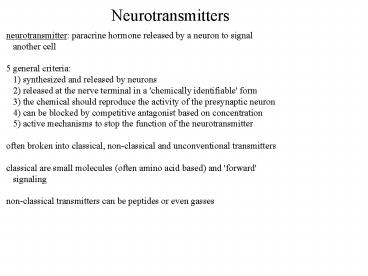Neurotransmitters - PowerPoint PPT Presentation
1 / 18
Title:
Neurotransmitters
Description:
signals (usually calcium) or. internal (constitutive) release. 4) binding to ... first discovered in the 1950's. 1) found in smaller, transparent vesicles ... – PowerPoint PPT presentation
Number of Views:128
Avg rating:3.0/5.0
Title: Neurotransmitters
1
Neurotransmitters
neurotransmitter paracrine hormone released by a
neuron to signal another cell 5 general
criteria 1) synthesized and released by
neurons 2) released at the nerve terminal in a
'chemically identifiable' form 3) the chemical
should reproduce the activity of the presynaptic
neuron 4) can be blocked by competitive
antagonist based on concentration 5) active
mechanisms to stop the function of the
neurotransmitter often broken into classical,
non-classical and unconventional
transmitters classical are small molecules
(often amino acid based) and 'forward'
signaling non-classical transmitters can be
peptides or even gasses
2
5 Steps of Neurotransmission
1) synthesis of the neurotransmitter
precursors and enzymes should be in the
correct place 2) storage of neurotransmitter
OR precursor often stored in presynaptic
vesicles classical usually smaller and
clear peptides 'dense core' and larger
3
5 Steps of Neurotransmission
3) release of the neurotransmitter generally
by vesicle fusion released by either
extracellular signals (usually calcium) or
internal (constitutive) release 4) binding to
target receptor may be on pre- and post-
cell! ionotropic receptors open ion
channels metabotropic receptors modulate
other signals
4
5 Steps of Neurotransmission
5) termination of the signal active
termination caused by reuptake or chemical
breakdown passive termination uses diffusion
5
Classical Neurotransmitters
first discovered in the 1950's 1) found in
smaller, transparent vesicles 2) actively
recycled at the presynaptic terminal 3)
synthesized at the nerve terminal by an
enzyme catecholamines dopamine, norepinephrine,
epinephrine only 1 catecholamine type per neuron
6
Catecholamines
catecholamines are synthesized from
tyrosine tyrosine hydroxylase is the rate
limiting step in catecholamine biosynthesis TH
activity is regulated by phosphorylation and
feedback inhibition
phenylethanolamine N-methyltransferase
PNMT S-adenosylmethionine
epinephrine
7
Catecholamines
catecholamines are stored in vesicles prior to
release VMAT vesicle monoamine transporter--
transporter protein which fills vesicles with
catecholamines in some neurons, VMAT can secrete
small amounts of catecholamines from
neurons inhibited by reserpine (shown bound to
VMAT transporter)
8
Catecholamines
autoreceptor cell surface receptor on the same
neuron secreting the catecholamine (autocrine
signaling pathway) stimulated at the same time
as the paracrine receptor some autoreceptors
work to inhibit further release of dopamine at
recently activated synapses, limiting
transmitter release other autoreceptors work to
inhibit TH enzymatic activity
9
Catecholamines
two enzymes chemically inactivate
catecholamines 1) MAO- monoamine oxidase
deaminates catecholamines - major enzymatic
target for a number of early anti-depressants de
prenyl, an MAO inhibitor, can treat symptoms of
Parkinson's disease 2) catecholamine
transporters- enzymes which reabsorb
catecholamines for reuse or recycling prozac,
zoloft and cymbalta are uptake inhibitors and
anti-depressants cocaine and amphetamine are
dopamine transporter inhibitors
10
Serotonin
serotonin (5-hydroxytryptamine, 5-HT) causes
smooth muscle contraction functionally similar
to catecholamines and is chemically
related chemically similar to LSD, and is
involved in schizophrenia depression inactivate
d mostly by SERT, a serotonin transporter related
to catecholamine transporters (often
inhibited by the same drugs)
LSD
11
Acetylcholine
neurotransmitter at neuromuscular junctions
(striated muscle) synthesized from choline (ie.
phosphatidylcholine) by acetylation using
acetyl CoA (from Krebs cycle) pumped into
vesicles using VChAT- vesicular cholinergic
transporter entire gene is in the first intron
of choline acetyltransferase, forcing these
genes to be regulated using the same
promoter inactivated by acetyl and butyryl
cholinesterases (AChE and BChE) irreversible
AChE inhibitors can be deadly toxins- curare,
sarin, VX reversible weak inhibitors may be
Alzheimer's disease treatments
12
Glutamate
main excitatory neurotransmitter along with
aspartate (identical to acidic amino
acids) formed from Krebs cycle by amination
of a-ketoglutarate VGLUT- vesicle glutamine
transporters- best marker for glutamatergic
synapses several isoforms are present at
different synapses astrocytes particularly have
glutamate uptake transporters some glia may also
release neurotransmitters, signaling to neurons
13
GABA- g-amino buytryic acid
major inhibitory transmitter glutamate (amino
acid) is converted into GABA by glutamic acid
decarboxylase (GAD) some GABAergic neurons
also glutamatergic (excitatory and
inhibitory) one receptor (GABAB) may be both
presynaptic regulating release and
postsynaptic (where it is not an autoreceptor) 4
transporters on neurons and glia uptake GABA to
inactivate it
14
Nonclassical Neurotransmitters
classical and nonclassical transmitters are found
at the same synapses peptide transmitters seem
to be released more effectively by bursts may
act as a different type of signal from the same
neuron invertebrates can localize
neurotransmitters to branches of an axon not
yet shown conclusively in mammals, but very
likely dozens of peptide neurotransmitters are
known with diverse functions substance P--
involved in pain signaling and mood disorders
neuropeptide Y-- increases food intake
bombesin-- decreases food intake
somatostatin-- regulates growth hormone release
15
Nonclassical Neurotransmitters
peptide hormones are synthesized as zymogens
(inactive pro-hormones) activated after being
sorted into vesicles in the golgi
complex synthesized in the cell body,
then transported to terminals using fast
axonal transport reacts more slowly to changes
in synthesis
16
Nonclassical Neurotransmitters
peptides are inactivated by diffusion or
breakdown- NOT reuptake peptide and receptor
complex can be endocytosed to inactive
them peptidases breaking down neuropeptide
hormones recognize dipeptides and can degrade
multiple peptide hormones
17
Unconventional Neurotransmitters
nitric oxide (NO) a gas produced at the synapse
and diffuses across the synapse has many
exceptions to normal neurotransmitters 1) not
stored at synapses (produced locally and used
immediately) 2) not exocytosed (diffuses
freely across membranes) 3) not intentionally
inactivated (very unstable and reactive) 4)
does not have cell surface receptors (diffuses
across membranes) often used as a retrograde
messenger- signals from postsynaptic cell
back toward the presynaptic one
18
Unconventional Neurotransmitters
endocannabinoids relatives of cannabis, have
their own receptors in the brain and normal
endogenous ligands synthesized from membrane
lipids and diffuses across membranes must be
used immediately inactivated by FAAH (fatty
acid amine hydroxylase) MGL
(monoacylglycerol lipase) anadamide
transporter endocannabinoids are retrograde
transporters like NO seems to be important in
learning and memory as well as food intake































